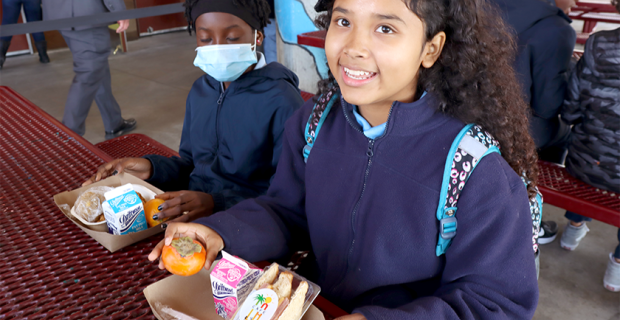Seven Proven Strategies to Increase Students’ Time to Eat

Students enjoying a school meal at Upland Unified. (photo credit: Upland Unified)
The importance of time to eat at school
- Research shows that when students have more time to eat (at least 25 minutes for lunch), they waste less food, eat more fruits and vegetables, and experience less hunger.
- Students who have the time they need to consume nutritious school meals do better academically.
- California school nutrition directors report an average of 15 minutes of “seat time,” with some districts reporting as little as 6 minutes according to a survey of 40 public school districts conducted by the Center for Ecoliteracy in 2022.
“An efficient cafeteria serving nutritious foods can support mindfulness, academic performance, athleticism, mental health, and lifelong healthy habits. If there isn't time for students to eat, these areas suffer.” –Kat Soltanmorad, RDN, Director, Food and Nutrition Services, Tahoe-Truckee Unified School District
Students now have less time to eat
As more California students participate in free School Meals for All, providing sufficient time to eat has been an increased focus for schools.
Students are choosing to forgo school meals due to long lines. Nutritious food is left uneaten because students don’t have time to finish their meals. These issues are not new, but they are worsening.
Demand for school meals has increased thanks to state investments that provide free meals for all students and more locally-sourced, freshly-prepared food. Some schools have seen meal participation double compared to prior to the pandemic. Truckee Elementary School now serves 787 meals each day, compared to 365 meals in 2018–19. More students participating in school meals may lead to longer lines and less time for students to eat.
1 - Additional points of service

Students at Natomas Unified enjoy meals from the food truck. (photo credit: Natomas Unified)
Food trucks, lunch carts, and other additional service points outside of the cafeteria can increase time to eat, especially if existing cafeterias have space constraints. By increasing points of service, lines are reduced, providing students with more time to enjoy school meals. In 2019, Natomas Unified purchased a food truck with a grant from No Kid Hungry. Vince Caugin, Director of Nutrition Services, says, “When our students aren't in the cafeteria, our Lunch Box truck meets them where they are. It can be found at sporting events, parks, and local libraries.” Many school districts have had success with mobile carts for “second chance breakfast” and food trucks for school lunches and celebrations. Consider leveraging state funding and grant programs to support additional service points.
2 - Multiple points of sale

Adding additional points of sale and creating multiple lines within the cafeteria can decrease the amount of time students spend in line. Since the passage of School Meals for All, Brentwood Union School District has seen a significant increase in the number of students they are serving. The district faced the challenge of serving twice as many students in the same amount of time. Multiple points of sale were created so over 200 students could go through the line in less than 10 minutes. Kristin Nisen, Nutrition Services Coordinator, says, “For elementary schools, we used double-sided lines and worked with principals to spread out classes so fewer students were coming through the lines at once. For middle schools, we added additional serving lines to provide every student with at least 15 minutes to eat.”
3 - More meal periods

Increasing from one meal period to two could halve the amount of time students spend waiting in line, and shorter lines mean more time to eat. At larger schools with hundreds or thousands of students, three or more meal periods may be required to meet the demand for school meals. At some schools, more meal periods have led to increased participation as students are no longer deterred by long lines.
4 - Speeding up the point of sale
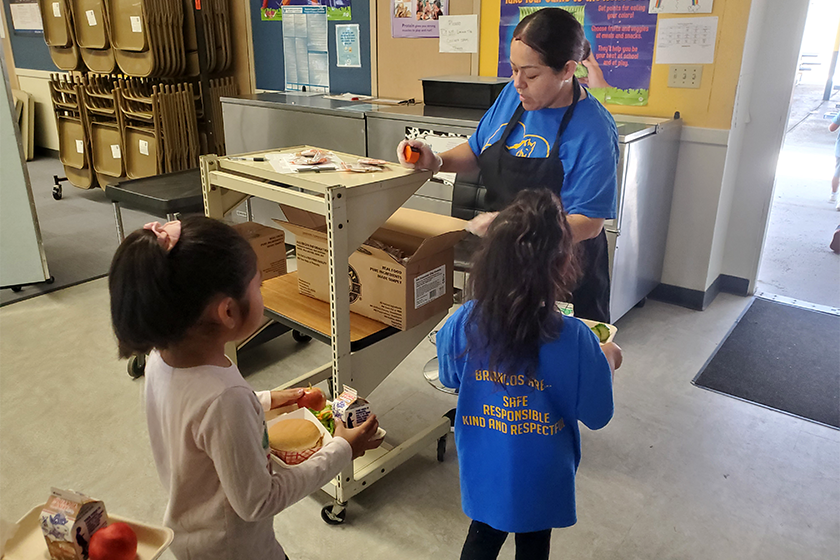
A school nutrition professional uses a tally system as students move quickly through the lunch line at Vista Unified. (photo credit: Vista Unified)
Efficiently moving students through the line can increase time to eat. Consider using Provision 2 or the Community Eligibility Provision so that students can be counted with a clicker or tally sheet instead of having to enter their ID numbers. At Vista Unified, high participation in school meals meant that some schools had just 20 minutes to move 1,000 kids through the lunch line. Jamie Phillips, former Director of Child Nutrition Services at Vista Unified, shared that using a tally sheet at elementary schools reduced point of sale time from 5-8 seconds to less than 5 seconds. “Students entered the cafeteria by classroom, and a single entrance and exit were established. The efficiency of the tally system allowed us the opportunity to redirect our efforts, such as enhancing our farm-to-school initiatives.”
5 - Serving food efficiently
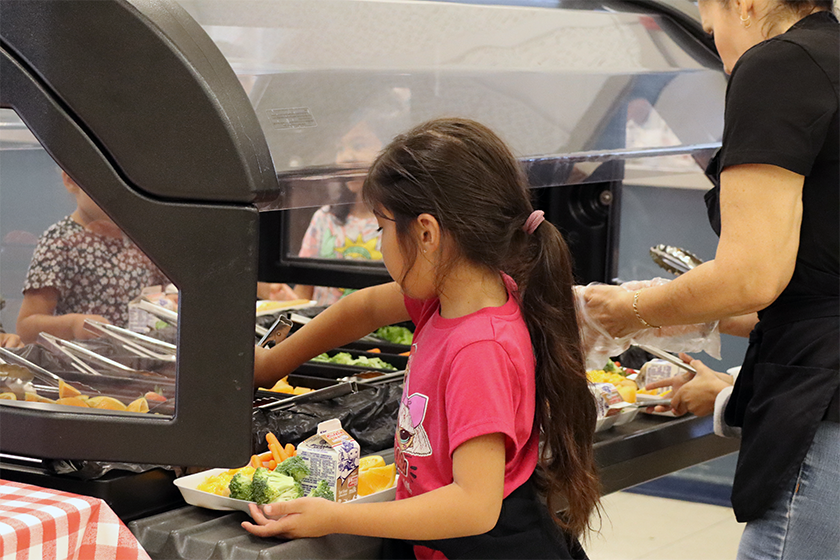
Riverside Unified’s “Farmer’s Market” salad bars are strategically located to avoid crowding.
Serving stations that optimize the placements of meals and instruct the flow of traffic (especially for offer vs. serve) provide students with more time to eat. There are many methods for more efficient serving lines, including pre-plating meals, positioning meal stations to create an orderly flow of students in the cafeteria, and designing menus with serving time in mind. Without careful consideration, some strategies could end up increasing food waste in the cafeteria. At Riverside Unified’s elementary schools, they display pre-plated sample reimbursable meals for students to preview as they’re waiting in line, helping students make faster decisions about their meal of choice. Riverside Unified also provides a monitored salad bar for students to add fresh produce onto their plates after the point of sale, which helps the main serving line move more quickly. Riverside Unified has worked to promote student choice while increasing the visibility of fruits and vegetables in the cafeteria.
6 - Breakfast in the classroom
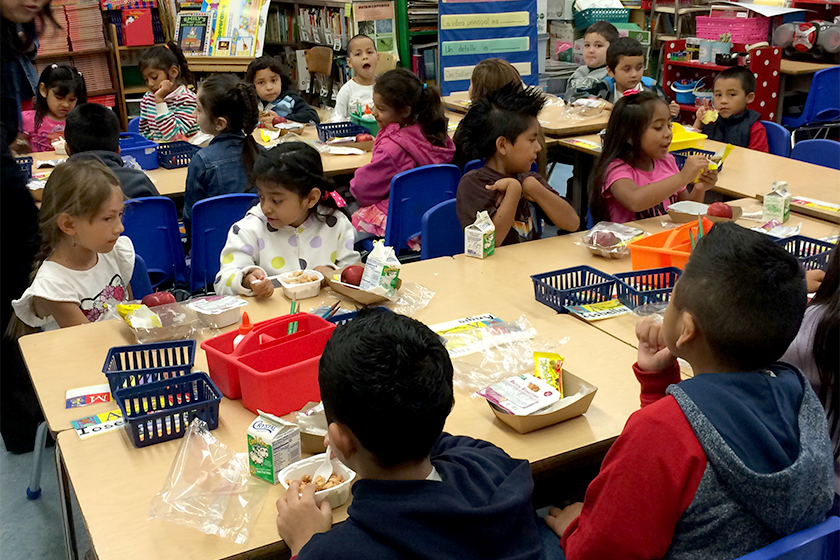
Students enjoy breakfast in the classroom at San Francisco Unified. (photo credit: San Francisco Unified)
Strategically timing meal periods can increase the time students have to eat. For instance, with Breakfast in the Classroom, students can eat during instructional time instead of rushing through breakfast to get to class. At San Francisco Unified, breakfast in the classroom has led to students being more attentive and less disruptive in class. On average, participation in breakfast increased from 17% to 65% after implementing breakfast in the classroom in 2014. Jennifer LeBarre, Executive Director of Student Nutrition Services, says, “Our Breakfast in the Classroom program allows us to meet students' breakfast needs when and where they need it. Families do not have to worry about getting their students to school early so that they can enjoy this important meal.” Another best practice is to schedule recess before lunch, so that students can participate in both activities, and don’t have to sacrifice time to eat to get outside, play, and socialize with classmates.
7 - Restructuring lunch schedules
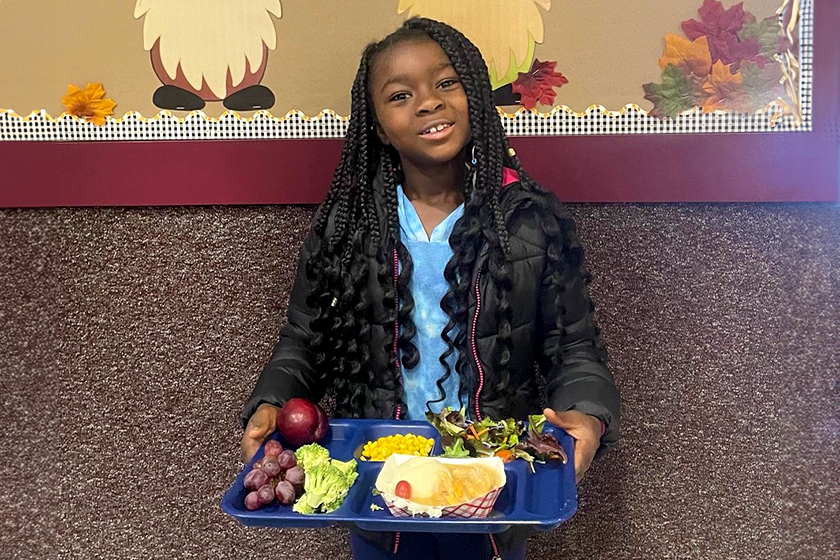
Student shows their school meal at Upland Unified. (photo credit: Upland Unified)
Increasing the time allotted for breakfast and lunch in the bell schedule increases the time for students to eat. This solution is effective but can be difficult to implement. Revising bell schedules to increase time to eat requires strong leadership from school administrators and can involve constraints in union contracts, bus schedules, and instructional minutes. School boards can pass wellness policies that require minimum amounts of seat time and individual principals can adjust the bell schedules at their schools. At Upland Unified, nutrition services staff were successful in working with two principals to adjust the bell schedules and allow more time to eat. Ksenia Glenn, Director of Nutrition Services, says, “The kitchen manager and principals worked together to stagger the schedule so that students entered the cafeteria and had recess by grade instead of in large groups. With less time waiting in line, this efficient schedule allowed more time for students to eat and play without adding minutes to the school day.”
Working together on time to eat
Some strategies to increase time to eat can be implemented by school nutrition directors and staff members, while other solutions involve the school board, principals, teachers, wellness committees, parents, and janitorial staff. Everyone has a role to play in supporting students’ time to eat:
- School principals and administrators: Partner with nutrition services to develop bell schedules to allow adequate time to eat, and schedule recess before lunch.
- School board and wellness committees: Update school wellness policies to codify a minimum amount of seat time for students after they have received their meals.
- Teachers and janitorial staff: Support breakfast in the classroom programs to increase time to eat without impacting instructional minutes.
- Parents and students: Talk to school principals, nutrition service directors, and policymakers about the importance of time to eat.
- School nutrition directors and staff: Speed up the point of sale or create more points of service to provide students with more time to eat. Frontline school nutrition staff often have the best ideas about how to make their cafeteria more efficient.
- Policymakers: Support policies requiring a minimum amount of seat time, and invest in school districts’ successful implementation of time to eat strategies, which can require additional staff time, equipment, and cafeteria modifications.
Supporting Resources
Some of these solutions are not free. For instance, to add an additional point of sale or extend the service time with multiple meal periods, you may need to employ more school nutrition professionals or extend hours for current staff. Other solutions will require new equipment, such as equipment to serve breakfast in the classroom. While some costs might be offset by the increased participation that comes from shorter lunch lines and more time to eat, additional investments may still be needed. Consider applying for state and federal grant programs to support these efforts. See the California Department of Education’s “Nutrition What's New” funding section for the latest opportunities. Other solutions to increase time to eat can be found in the California Department of Education’s, “Ensuring Adequate Time to Eat” resource.
Acknowledgments
We are grateful to the following school nutrition leaders who contributed to this resource:
- Adleit Asi, Nutrition Services Director, Riverside Unified School District
- Vince Caguin, Director of Nutrition Services, Natomas Unified School District
- Juliana Cohen, PhD, Professor, Harvard School of Public Health
- Michelle Drake, Director, Food and Nutrition Services, Elk Grove Unified School District
- Ksenia Glenn, Director of Nutrition Services, Upland Unified School District
- Kenneth Hecht, J.D., Coordinator, UC ANR Nutrition Policy Institute
- Jennifer LeBarre, Executive Director, Student Nutrition Services, San Francisco Unified School District
- Jennifer McNeil, Co-founder, LunchAssist
- Kristin Nisen, Coordinator, Nutrition Services, Brentwood Union School District
- Jamie Phillips, former Director of Child Nutrition Services, Vista Unified School District
- Kat Soltanmorad, RDN, Director, Food and Nutrition Services, Tahoe-Truckee Unified School District
- Eric Span, Nutrition Services Director, Sweetwater Union High School District
- Karly Wasung, MDA, RDN, Director of Child Nutrition Services, Vista Unified School District


